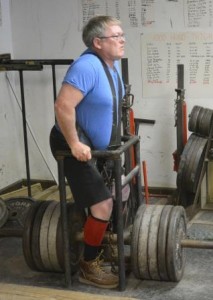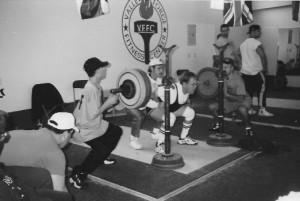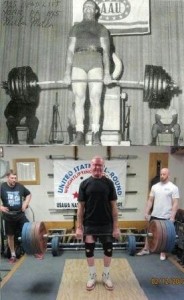By Bill Clark
Twenty five years ago, Harrisburg’s John Carter was on the top of the weightlifting world, then he disappeared only to resurface in recent months at Clark’s Gym – still the guy to beat when it comes to the world of chain lifting.
A quarter of a century ago, John, now 61 and looking as trim and fit as he did in 1988 when he first showed up in Clark’s Gym, compiled such world class marks as 3,405 pounds in the harness lift; 2,805 in the back lift; 2,525 in the hip lift: and 2,000 in the Carter Lift, named for him because few others in the lifting world even attempted it.
In his first meet back in 20 years, just before the corona virus pandemic hit, he took the title in the meet named for his main adversary of three decades ago – the Steve Schmidt Backbreaker Pentathlon. Steve was on hand to officiate.
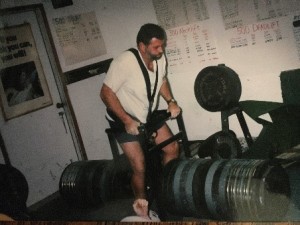
John Carter about to complete his 3,405 pound harness lift. Note the position of his left hand .
And just who is this John Carter?
Let’s say he’s a survivor.
John was born November 28, 1958, the son of John Jerome Carter, Sr., and Delores Carter. He attended school at Harrisburg from the first through the ninth grades, but left school at age 16 never to return.
His dad was a heavy equipment operator and John wanted to follow in his dad’s footsteps. By the time he was eight years old, he was operating his dad’s bulldozer and soon thereafter was driving a car around the area.
At age 12, he took the family car to town, ran out of gas at the courthouse and approached life from a different angle for years to come.
In his junior high years, John showed his athletic ability and his strength by setting the school records in the shot and discus and playing basketball, but he also was plagued by discipline matters.
In the seventh grade, he took issue with a classmate in a gym class and went to fists, as he was wont to do on too many occasions then and later. In the fight that followed, John’s punch missed the opponent’s head and he hit the wall behind, breaking his arm in six places and shattering his wrist.
John had a powerful punch, but not well-directed.
The injury almost cost him his athletic future. He had to have plates inserted in the wrist that left it fixed in place without flexibility – and a four-month stay at Boone Hospital. Fortunately, it was his left hand. The plates are still there.
Even to this day, the injury hampers his mechanics as a lifter and golfer that requires modification of leverages and style, but not with final results.
When John reported to Harrisburg High to start his sophomore year, he was told his hair was too long and after a battle with administration, he left school three years short of graduation to get into the construction world at age 16. The bulldozers quickly followed.
John then began a journey through life that was filled with twists and turns. He spent two years at MFA Feed and Supply, worked concrete for NuWay Construction, was in a concrete footing business with two partners for three years, moved on to work on the development of Cedar Lake for Terry Sapp, supplemented his income by cutting tobacco for Henry Lamb, the “Tobacco King,” married, had a son, Jason (who is his best friend), divorced, then moved on to work for Columbia Public Works, retiring, after 23 years, in 2002.
He spent much of his career on the seat he loved the most – handling a bulldozer and heavy equipment. He still enjoys that role. He has owned Carter Construction since retiring from the city – which coincided with John’s fade from the world lifting scene.
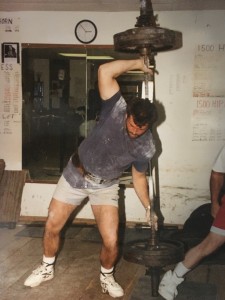
John about to shoulder a 375-pound personal record Steinborn lift. Note the left hand position.
THE CARTER SPORTS WORLD
One of the personal losses that came with being a high school dropout was leaving behind his love of competitive athletics.
He soon joined a Looper League softball team, then spent the next 20 years as a slow pitch softball player.
“My career ended when I blew up at an umpire’s call and he threw me out of the game and said: ‘Don’t ever come back out here.’ The umpire was one of my friends at work, Bill Crum. I never went back.”
In 1982, he discovered bowling and was a regular on the lanes in Columbia for 20 years – good enough to carry a 190-plus average and add an 800 patch to his awards showcase. His high game was 297.
Golf came next – in 1986. The game proved to be a real challenge. The shattered left wrist caused John to develop a different stroke, but he can still drive past the 300-yard mark. Golf has been a part of life for almost four decades.
In 1988, for a reason John cannot recall, he decided to take up weightlifting. Clark’s Gym had just opened and, after visiting other gyms in Columbia, he gave Clark’s a look – and immediately joined.
“I made the right choice,” he said recently. “The gym saved my life.
“When I was going through my divorce, the gym became the place I could vent my anger. More than once, I almost let my anger misdirect me, but I would detour to the gym.”
John was an immediate world class lifter. To meet him on the street or even in workout gear, he looks normal. He’s 5-11, weighs around 215, has surprisingly slender legs and trim middle.
Within a year, he had emerged as a world class lifter, winning both the national and world all-round titles in 1989 in Philadelphia.
In a four-year stretch between 1994 and 1997, he won the national title and added golds in two of the toughest strength tests around – the Backbreaker Pentathlon and the Zercher Memorial.
In 1995, he performed the difficult combination hip lift and squat with 2,000 pounds – a lift that carries his name. No one else has done half that poundage.
He is proud of his gym record of doing a single workout (two hours long) of 1,821 reps in the hip lift with 1,100 pounds – a total workout of 2,002,100 pounds.
In 1992, he met Diane Stone and she led the family cheering section in 1994 when John won a Gold Cup in Cleveland, Ohio, by setting a world record in the harness lift. She is still his head cheerleader.
Then, in 2004, it all ended. The business was a one-man operation and time-consuming. As it grew, so did the distance between John Carter and Clark’s Gym.
On rare occasion, he would drop in, tell stories with the owner about days gone by, see if he could still do a 1,500-pound hip lift, then disappear for a few more years.
Late in 2019, he found that, at age 60, he had trouble with 1,000 in the hip lift – and the reality of aging shocked him into action.
For 60 years, he had been headstrong, defiant, living life head-on, willing to fight. He lifted weights with the same mindset. Strength meant more than technique, and failure was not tolerated as a chance to do things different.
Diane and being a business owner had both helped him get control. Golf, too, had been a stabilizer. He could still hit the ball hard, but he had to master the other shots as well.
Now, back n the gym full-time since 2004, John is the teacher as well as the student. He has accepted the fact that, at 61, he is no longer 31, and that a harness lift of 3,405 will never happen again and that 2,405 is a more reasonable goal – and still a world record for 61-year-olds.
Last month, in an unsanctioned competition to do 61 different lifts at age 61, John exceeded the existing national records in over 50 events for the 100-kilo class in the 60-64 age group.
Welcome home, John!!
